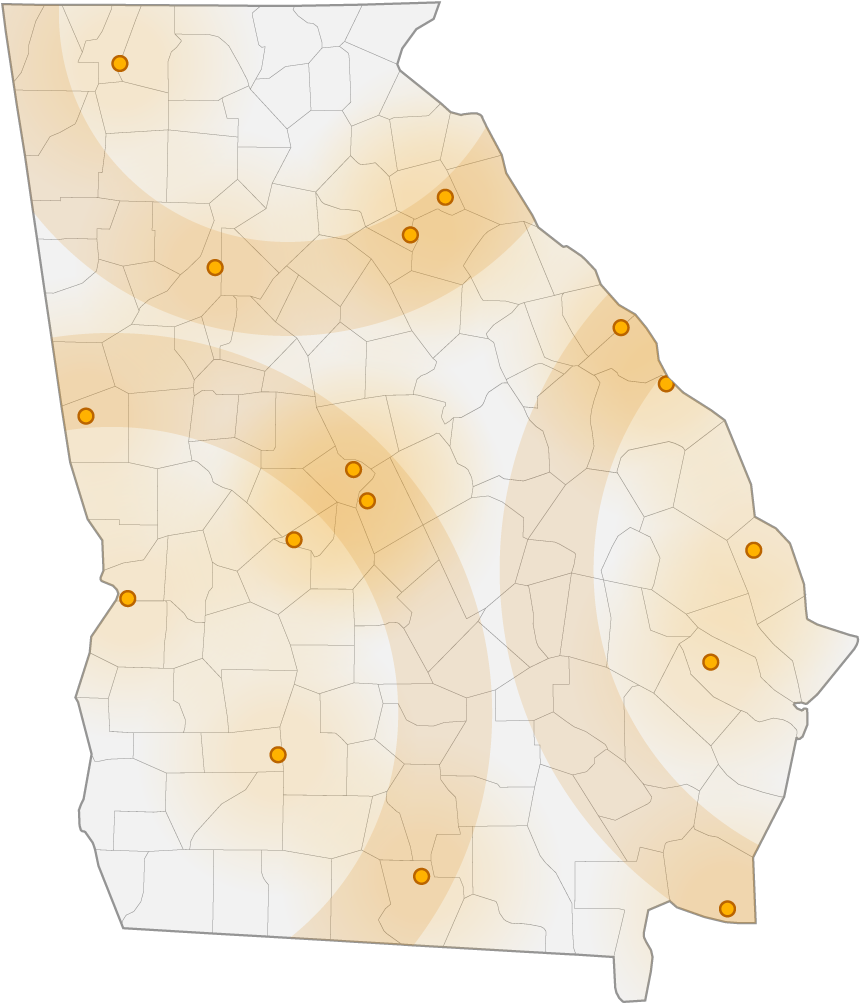

Sunlight is one of Georgia’s most abundant resources with an average of 218 sunny days per year. More than 3,000 MW of solar resources, or approximately 12% of our total capacity*, generate significant carbon-free energy for Georgians during sunny, daylight hours.
Georgia has consistently been in the SEIA Top 10 for solar photovoltaic installations for the past 10 years, and our state has one of the largest voluntary solar portfolios in the country.
Our capacity mix reflect nameplate capacity for renewable resources, program capacities for third-party Demand-Side Options (DSOs), and designated/demonstrated capacity for the remaining fuel types. A portion of the renewable generation capacity includes capacity where the renewable generator retains the related Renewable Energy Credits (RECs).
A photovoltaic solar panel system requires little maintenance and can produce power for more than 20 years.

Panels absorb photons from the sun that begin to stimulate the electrons in the panel material.

Eventually enough movement causes the electrons to split off from their atoms.

The electrons are then guided in an ordered fashion, forming an electrical current.
Not all solar facilities you may come across belong to Georgia Power. We have constructed and are operating 16 solar farms and additional demo facilities across the state of Georgia, many in partnership with military installations. The largest, at 128 MW of capacity, is located at Robins Air Force Base in Warner Robins, Georgia. Other facilities add carbon-free energy to the grid and supply renewable energy in support of our Community Solar program.

![]()
| Comer | 2,160 kW |
| Dalton | 6,508 kW |
| Falcons Solar | 1,019 kW |
| UGA | 984 kW |
![]()
| Fort Benning | 30,005 kW |
| Fort Valley | 10,800 kW |
| LaGrange | 800 kW |
| MCLB | 31,161 kW |
| Moody AFB | 49,500 kW |
| Robins AFB | 128,000 kW |
| Tri-County EMC | 1,008 kW |
![]()
| Fort Gordon | 30,000 kW |
| Fort Stewart | 30,000 kW |
| Guyton | 3,600 kW |
| Kings Bay | 30,161 kW |
| Waynesboro | 2,400 kW |
![]()
| Comer | 2,160 kW |
| Dalton | 6,508 kW |
| Falcons Solar | 1,019 kW |
| UGA | 984 kW |
| Fort Benning | 30,005 kW |
| Fort Valley | 10,800 kW |
| LaGrange | 800 kW |
| MCLB | 31,161 kW |
| Moody AFB | 49,500 kW |
| Robins AFB | 128,000 kW |
| Tri-County EMC | 1,008 kW |
| Fort Gordon | 30,000 kW |
| Fort Stewart | 30,000 kW |
| Guyton | 3,600 kW |
| Kings Bay | 30,161 kW |
| Waynesboro | 2,400 kW |
From home installation or buy back programs, to workplace solutions or non-installation options, our goal is to make solar an option for every Georgia Power customer. Not sure what solution is right for you? Use our solar adviser tools to find the best solution for your sustainability goals.
![]()
![]()
Solar panels absorb energy from the sun by way of a semiconductor (typically silicon) and generate a direct current electrical source. An inverter is used to convert the source to an alternating current source. Learn more about How Solar Works.
Yes, as long as the location selected is clear of obstructions that will block the sunlight. Some shading may be unavoidable, but you want it to have direct sunlight most of the time. Please review our Solar Programs to learn more.
Yes, Southern Company and EPRI are currently testing multiple PV technologies in Georgia and across our territory.
Some of the key ways solar PV technologies differ is by temperature coefficient and efficiency. The temperature coefficient represents the relative change in power output with respect to the ambient temperature. Solar panel efficiency is related to the quality of the panels and solar cell technology (monocrystalline, polycrystalline, thin film). Panel efficiency commonly ranges from 12-21 percent with respect to the cell technology.
Please view our Solar Programs to find out more about partnering with Georgia Power on your solar installation. You can also check with qualified installers through NABCEP for their recommendations on the correct system to meet your needs.
Yes, clouds can diffuse and/or block sunlight. This will restrict the amount of sunlight absorbed by the solar panels and can reduce the energy output by 40-90 percent.
An uncapped 30 percent Federal Investment Tax Credit (ITC) is available to homeowners for solar equipment placed in service by December 31, 2019. The tax credit will be 26 percent for systems placed in service in 2020, 22 percent for systems in service in 2021, and 0 percent for systems in service after 2021. For commercial systems placed in service after 2021, the tax credit will be 10 percent (Business ITC). Find information about tax incentives at the Database of State Incentives for Renewable Energy and Energy.gov. Please consult your tax advisor to determine how this federal incentive may apply to your particular circumstances.